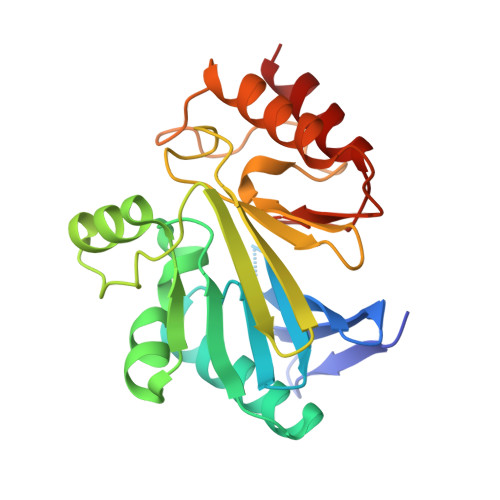Evidence of adaptability in metal coordination geometry and active-site loop conformation among B1 metallo-beta-lactamases .
Gonzalez, J.M., Buschiazzo, A., Vila, A.J.(2010) Biochemistry 49: 7930-7938
- PubMed: 20677753
- DOI: https://doi.org/10.1021/bi100894r
- Primary Citation of Related Structures:
3I0V, 3I11, 3I13, 3I14, 3I15 - PubMed Abstract:
Subclass B1 beta-lactamases are Zn(II)-dependent hydrolases that confer bacterial resistance to most clinically useful beta-lactam antibiotics. The enzyme BcII from Bacillus cereus is a prototypical enzyme that belongs to this group, the first Zn(II)-dependent beta-lactamase to be discovered. Crucial aspects of the BcII catalytic mechanism and metal binding mode have been assessed mostly on the Co(II)-substituted surrogate. Here we report a high-resolution structure of Co(II)-BcII, revealing a metal coordination geometry identical to that of the native zinc enzyme. In addition, a high-resolution structure of the apoenzyme, together with structures with different degrees of metal occupancy and oxidation levels of a conserved Cys ligand, discloses a considerable mobility of two loops containing four metal ligands (namely, regions His116-Arg121 and Gly219-Cys221). This flexibility is expected to assist in the structural rearrangement of the metal sites during catalytic turnover, which, along with the coordination geometry adaptability of Zn(II) ions, grants the interaction with a variety of substrates, a characteristic feature of B1 metallo-beta-lactamases.
- Instituto de Biología Molecular y Celular de Rosario (IBR), Consejo Nacional de Investigaciones Científicas y Técnicas (CONICET), Facultad de Ciencias Bioquímicas y Farmacéuticas, Universidad Nacional de Rosario (UNR), Suipacha 531, S2002LRK Rosario, Argentina.
Organizational Affiliation:

















